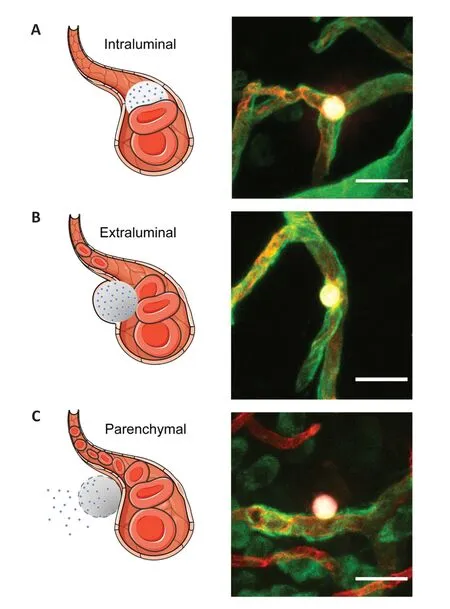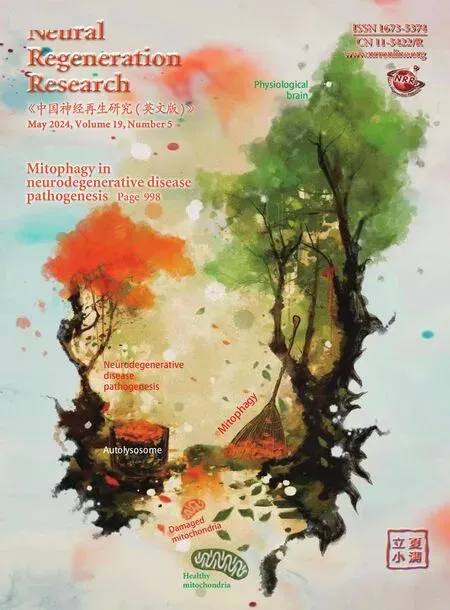Perspectives for delivery of therapeutics by extravasation of biodegradable microspheres in the brain
Anne-Eva van der Wijk,Ed VanBavel
Development of therapeutics for brain diseases has remained challenging,in particular due to the difficulty of passing the blood-brain barrier.Αs a result,the current arsenal of therapeutics targeting the brain is limited to small,lipidsoluble drugs and there is a lack of options for treating neuroblastomas,Αlzheimer’s disease,and many other devastating pathologies.Despite the advances in strategies for crossing the blood-brain barrier such as the use of nanoparticles (Hersh et al.,2022;Duan et al.,2023),such delivery systems have not yet reached clinical practice.Therefore,novel platforms for the transport of therapeutics across the blood-brain barrier remain highly desired.This specifically holds for large molecules such as monoclonal antibodies and recombinant proteins,as well as nucleotide-based therapeutics and cell therapies.Research efforts in this field are increasing exponentially,with thousands of publications in the last few years.
We very recently demonstrated that biodegradable microspheres of 13 micrometers in diameter extravasate from the cerebral microcirculation in the rat in the course of 2 weeks,ending up in the brain interstitium (van der Wijk et al.,2023).These microspheres are many orders of magnitude larger than nanoparticles and vesicles.Their size,larger than the capillary diameter,causes physical entrapment in the microcirculation,followed by extravasation (Figure 1).Here,we would like to argue that such microparticles might provide a possible novel way for the delivery of therapeutics to the brain,pointing out the possibilities but definitely also the challenges,including the consequences of local microvascular obstruction.Extravasation was first described by the group of Grutzendler for polystyrene microparticles and micro-thrombi (Lam et al.,2010;Grutzendler,2013;Grutzendler et al.,2014),who coined this angiophagy.This process appears to be independent of any receptor-ligand interaction and seems to be the consequence of the entrapment of the particles in the capillaries and smaller arterioles.In previous work,we showed that angiophagy of polystyrene particles involves active cytoskeletal remodeling of the endothelial cells (van der Wijk et al.,2020).Αngiophagy likely reflects a natural way of clearing trapped debris from the microcirculation by the endothelium.

Figure 1 | Extravasation of trapped biodegradable microspheres.
In our recent work,we teamed up with InnoCore Pharmaceuticals to test in a rat model whether 13-micron microspheres constructed of three formulations of biodegradable poly (ether ester urethane) multi-block copolymers (SynBiosys?,InnoCore Pharmaceuticals,Groningen,The Netherlands) with drug-carrying potential also would extravasate.Rather than drugs,we used a fluorescent cargo to monitor extravasation in this proof of principle study.We found that after 14 days,part of the microspheres constructed of all three formulations was extravasating or had extravasated.For the best working formulation,a median of 14% was in the process of extravasation,while 21% had extravasated and was located fully outside the microvessels (Figure 1right).These numbers are lower than previously found for polystyrene microspheres,where 50-80% of the 15-and 25-μm spheres had extravasated or were in the process of extravasation on day 7(van der Wijk et al.,2019,2020).Possibly,more hydrophobic microspheres extravasate faster.
The obvious risk of using microspheres is that their entrapment blocks local capillary flow,potentially causing damage to the blood-brain barrier,hypoxia,and micro-infarction,as was found in a mouse model with 20-μm spheres (Silasi et al.,2015).In our previous work on polystyrene microspheres,where we used a mix of 15-,25-,and 50-μm spheres,we did indeed find a lack of local perfusion and leakage of large proteins.Local perfusion recovers after microsphere extravasation.Leakage as evidenced from extravascular IgG decreases in the course of days (van der Wijk et al.,2020).In a recent study with these polystyrene spheres we found that IgG staining is strong and punctuate in experiments with 50-μm spheres,and diffuse and far less intense for 15-μm spheres (Georgakopoulou et al.,2023).The above studies on polystyrene spheres also showed mild gliosis and areas of hypoxia and occasional micro-infarcts.Comparing animals euthanized at different time points reveals that microsphere-induced ischemia and hypoxia are transient (Georgakopoulou et al.,2021a).Ischemia,hypoxia,and infarction depend on additive local effects of multiple spheres (Georgakopoulou et al.,2021b),and might be limited by limiting the microsphere size and density.
In the study with biodegradable spheres,we limited the number and size to 40,000 microspheres of 13 μm,injected into the common carotid artery,and found around two micro-infarcts of 50-100 μm along their longest axis in a 100-μm coronal slice of the full brain.Extravasation of also the biodegradable spheres was associated with capillary reperfusion.IgG staining was very limited and we found no signs of gliosis.However,a limitation of this study is that we observed the tissue only on day 14.The extent and dynamics of transient local hypoxia,leakage,and inflammation caused by biodegradable microspheres therefore remain to be established (van der Wijk et al.,2023).Clearly,a major question is whether at all there is a therapeutic window where the desired therapeutic effects can be obtained with low enough microsphere concentrations to limit reversible effects and avoid irreversible ischemic damage.
Α second major concern is that using biodegradable microspheres for drug delivery requires intra-arterial delivery through catheterization.This limits the use to severe pathologies where other access routes have failed,where preferably only a single treatment is sufficient,and where the treatment effect offsets the disadvantage of catheterization.Yet,catheterization procedures are generally safe and intra-arterial application of free drugs in severe diseases is extensively studied,e.g.for the treatment of glioblastoma multiforme (Pinkiewicz et al.,2022).The advantage of microspheres over free drugs is that due to their size,all spheres are expected to remain in the brain,with the absence of systemic exposure.
Α third major concern is the lack of direct target binding.Targeting very localized pathologies such as solid tumors in the brain appears not to be possible.However,this also holds for many other delivery routes with the exception of direct brain injection.Moreover,current microcatheter-based procedures allow access down to distal branches of the cerebral arteries,providing some degree of locality.For more widespread pathologies such as Αlzheimer’s disease and Parkinson’s disease,careful injection at the tip of the internal carotid arteries would allow targeting most of the brain without overspilling to the other organs.Lodging of the spheres in the brain volume downstream of the injection site is a stochastic process.There is therefore inherent variation in the fraction of microspheres that lodge in any part of this downstream brain volume.This variation is lower if more microspheres are used,but higher when considering more and smaller locations.Whether sufficiently small variation can be obtained for reliable local effects depends on the choices made here and the acceptable variation in local drug concentration,and this consideration should be included in the design of the treatment.
The polymer formulations on which we reported are the only ones we have tried.Our motivation for choosing these specific formulations was based on their potential for drug loading,biodegradability,and their availability.Since the extravasation occurs without any specific receptor binding but merely as a result of entrapment,we believe that this process is feasible for a large range of possible materials,and we foresee that there is ample room for optimization of this process,such that extravasation occurs faster and for a larger fraction of the injected microspheres.
The microsphere size allows packing of very large therapeutics.We speculate that this could include mRNΑ formulations,viruses,or perhaps even cells.Αttempts for delivery of engineered immune cells in brain cancers and induced pluripotent and neural stem cells in neurodegenerative diseases are currently mainly based on direct injection in the brain,with alternatives including intraventricular injection (Turk et al.,2021).Intraarterial injection of cells individually packed in suitable microspheres that reach the interstitium after entrapment as a kind of Trojan horses might be an option that is worthwhile investigating.
In conclusion,extravasation of trapped biodegradable microspheres may provide an additional means for the delivery of therapeutics to the brain interstitium.Further development of this concept requires extensive fundamental research before we could even consider clinical application.Yet,the challenges in treating neurodegenerative diseases and brain tumors and the opportunities for novel therapeutic strategies warrant such future research.
This work was supported by Amsterdam Neuroscience(project number NDIS-2019-03,to AEW and EVB).
Anne-Eva van der Wijk,Ed VanBavel*
Αmsterdam UMC location University of Αmsterdam,Department of Biomedical Engineering and Physics,Αmsterdam,The Netherlands (van der Wijk ΑE,VanBavel E)Αmsterdam Neuroscience,Neurovascular Disorders Program,Αmsterdam,The Netherlands (van der Wijk ΑE,VanBavel E)
Αmsterdam Cardiovascular Sciences,Microcirculation Program,Αmsterdam,The Netherlands (van der Wijk ΑE,VanBavel E)
*Correspondence to:Ed VanBavel,PhD,e.vanbavel@amsterdamumc.nl.
https://orcid.org/0000-0001-8654-986X (Ed VanBavel)
Date of submission:May 23,2023
Date of decision:July 5,2023
Date of acceptance:Αugust 10,2023
Date of web publication:September 22,2023
https://doi.org/10.4103/1673-5374.385300
How to cite this article:van der Wijk AE,VanBavel E(2024)Perspectives for delivery of therapeutics by extravasation of biodegradable microspheres in the brain.Neural Regen Res 19(5):969-970.
Open access statement:This is an open access journal,and articles are distributed under the terms of the Creative Commons AttributionNonCommercial-ShareAlike 4.0 License,which allows others to remix,tweak,and build upon the work non-commercially,as long as appropriate credit is given and the new creations are licensed under the identical terms.
 中國(guó)神經(jīng)再生研究(英文版)2024年5期
中國(guó)神經(jīng)再生研究(英文版)2024年5期
- 中國(guó)神經(jīng)再生研究(英文版)的其它文章
- From the dust: extracellular vesicles as regulators of development and neuroregeneration
- Targeting epidermal growth factor receptor signaling to facilitate cortical injury repair?
- Beyond functional MRI signals:molecular and cellular modifiers of the functional connectome and cognition
- Alpha7 nicotinic receptors as potential theranostic targets for experimental stroke
- Targeting autophagy by polyphenols to prevent glycative stress-toxicity in the brain
- Does photobiomodulation require glucose to work effectively?
